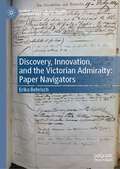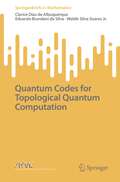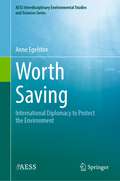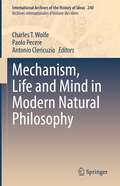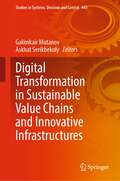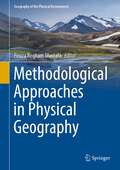- Table View
- List View
Stochastic Elasticity: A Nondeterministic Approach to the Nonlinear Field Theory (Interdisciplinary Applied Mathematics #55)
by L. Angela MihaiStochastic elasticity is a fast developing field that combines nonlinear elasticity and stochastic theories in order to significantly improve model predictions by accounting for uncertainties in the mechanical responses of materials. However, in contrast to the tremendous development of computational methods for large-scale problems, which have been proposed and implemented extensively in recent years, at the fundamental level, there is very little understanding of the uncertainties in the behaviour of elastic materials under large strains.Based on the idea that every large-scale problem starts as a small-scale data problem, this book combines fundamental aspects of finite (large-strain) elasticity and probability theories, which are prerequisites for the quantification of uncertainties in the elastic responses of soft materials. The problems treated in this book are drawn from the analytical continuum mechanics literature and incorporate random variables as basic concepts along with mechanical stresses and strains. Such problems are interesting in their own right but they are also meant to inspire further thinking about how stochastic extensions can be formulated before they can be applied to more complex physical systems.
Radiation Therapy for Sarcomas and Skin Cancers: A Practical Guide on Treatment Techniques (Practical Guides in Radiation Oncology)
by Edward Kim Upendra Parvathaneni Meng Xu WelliverThis practical guide to the use of radiotherapy for the treatment of sarcomas and skin cancers covers a wide range of disease scenarios, identifying which treatment techniques are applicable in particular clinical circumstances. Among the conditions considered are extremity soft tissue sarcomas, retroperitoneal soft tissue sarcomas, bone sarcomas, uterine sarcomas, chordomas, pediatric sarcomas, squamous cell carcinomas, basal cell carcinomas, melanomas, Merkel cell carcinomas, and cutaneous lymphomas. Detailed attention is devoted to the issues and considerations of relevance in everyday practice when treating these diseases. The use of multiple radiotherapy techniques and procedures, including IMRT, brachytherapy, radiosurgery, and particle therapy, is fully explained, and the role of radiotherapy in combination with chemotherapy and emerging therapeutics such as immunotherapy and biologic anticancer agents is also addressed. The book will be of high value for practicing radiation oncologists, medical and surgical oncologists, medical physicists, medical dosimetrists, trainees, and other medical professionals.
Discovery, Innovation, and the Victorian Admiralty: Paper Navigators (Global Studies in Social and Cultural Maritime History)
by Erika BehrischThis book examines the British Admiralty’s engagement with science and technological innovation in the nineteenth century. It is a book about people, and gross misunderstanding, about the dreams and disappointments of scientific workers and inventors in relation to the administrators who adjudicated their requests for support, and about the power of paper to escalate arguments, reduce opinions, and frustrate hopes. From instructions for naval surveying to debates about rewards to civilians for inventions, Paper Navigators puts a wide range of primary sources in the context of public debates and explores the British Admiralty’s engagement with, decision-making around, and management of questions of value, support, and funding with citizen inventors, the broader public, and their own employees. Concentrating on the Admiralty’s private, internal correspondence to explore these themes, it offers a fresh perspective on the Victorian Navy's history of innovation and exploration and is a novel addition to literature on the history of science in the nineteenth century.
Academic Entrepreneurship
by Gary E. HarmanThis book explores different aspects of entrepreneurship from both an academic and a commercial point of view. The first chapter the university culture is considered. The nature of the technology or service is important. Some technologies are adaptive, in that they are developing products that are already in the marketplace, and these fit easily in academic institutions. Other technologies are disruptive and new products must be developed. These fit less easily into university structures since a commercial entity is required. Chapter 4 considers the important requirements of conflict of interest (COI). Either the university culture or COI can hinder or aid entrepreneurial faculty. The second chapter deals with the reasons why an individual faculty might wish to become entrepreneurial. In many cases, a faculty member wants to see their technology in practice and not just a publication in a scientific journal. If a technology is disruptive, then a commercial entity is probably essential. If so, then funding must be obtained. There are “valleys of death” (1) where scientific discoveries to useful products and (2) the development, production and marketing of a commercially viable product. Chapter 6 deals specifically with methods of funding start-up companies. Chapter 3 describes several innovative programs in biology. These include genetic approaches, plant management systems and the author’s own program that deals with microbial approaches to sustainable agriculture. Chapter 5 describes the crucial areas of agreements, contracts, regulatory affairs and patents. These legal documents are critical components of entrepreneurial efforts and must be understood and pursued correctly. Finally, this book could have been entitled “things I wish I had known when I first started commercial activities.” It is my hope that it can make the path of fledgling entrepreneurial smoother and more successful.
Quantum Codes for Topological Quantum Computation (SpringerBriefs in Mathematics)
by Clarice Dias Albuquerque Eduardo Brandani Silva Waldir Silva Soares Jr.This book offers a structured algebraic and geometric approach to the classification and construction of quantum codes for topological quantum computation. It combines key concepts in linear algebra, algebraic topology, hyperbolic geometry, group theory, quantum mechanics, and classical and quantum coding theory to help readers understand and develop quantum codes for topological quantum computation.One possible approach to building a quantum computer is based on surface codes, operated as stabilizer codes. The surface codes evolved from Kitaev's toric codes, as a means to developing models for topological order by using qubits distributed on the surface of a toroid. A significant advantage of surface codes is their relative tolerance to local errors. A second approach is based on color codes, which are topological stabilizer codes defined on a tessellation with geometrically local stabilizer generators. This book provides basic geometric concepts, like surface geometry, hyperbolic geometry and tessellation, as well as basic algebraic concepts, like stabilizer formalism, for the construction of the most promising classes of quantum error-correcting codes such as surfaces codes and color codes.The book is intended for senior undergraduate and graduate students in Electrical Engineering and Mathematics with an understanding of the basic concepts of linear algebra and quantum mechanics.
Marine Mammals: A Deep Dive into the World of Science
by Dennis Brennecke Katrin Knickmeier Iwona Pawliczka Ursula Siebert Magnus WahlbergThis highly-readable Open Access textbook provides basic background information about marine mammals and anthropogenic impacts on them. The book includes inspiring exercises for education school programs in natural sciences. The book also provides advice on career paths using case studies of marine scientists and veterinarians describing their journeys from student to profession. By sharing real-life career paths, readers find answers to questions such as “What needs to be considered when choosing a career in science?” and “What kind of tasks do scientists undertake on a daily basis?” Marine mammals are amongst some of the most celebrated creatures on Earth, with their high intelligence, social and communicating skills, and capacity for deep diving. Alongside general information about marine mammals, the book aims at generating awareness of the impact of litter and noise pollution on the marine environment using marine mammals as an example. Huge numbers of marine animals, including marine mammals, die every year from entanglement in fishing gear, by ingestion of litter or because of chemical pollution. In the last decade many technological and scientific tools have been developed to aid research, for instance miniaturised sound recorders which can be attached to cetaceans and seals and record noise levels around them, their vocal production as well as their diving behaviour. This Open Access textbook can be used by undergraduate students interested in the fundamentals of marine mammal biology and medicine, and in pursuing the profession of a marine scientist.
Antiprotozoal Drug Development and Delivery (Topics in Medicinal Chemistry #39)
by Alane Beatriz Vermelho Claudiu T. SupuranThis book reviews new promising drug targets for Neglected Tropical Diseases (NTDs), with a special focus on antiprotozoal drugs against trpyanosomatids Trypanosoma cruzi and Leishmania spp. The book offers a comprehensive overview of the most recent studied targets, and it outlines classical and new treatments and delivery strategies. Expert contributors describe new methods of analysis and bio-prospecting for new compounds, and provide a critical perspective of the translational process used in the research and development of new drug candidates. The book will appeal not only to researchers, students and professionals interested in drug development to protozoan diseases, but also to medicinal chemists in general.
One-Carbon Feedstocks for Sustainable Bioproduction (Advances in Biochemical Engineering/Biotechnology #180)
by An-Ping Zeng Nico J. ClaassensThis book offers a comprehensive review of the latest developments, challenges and trends in C1-based (one-carbon based) bioproduction, and it presents an authoritative account of one-carbon compounds as promising alternative microbial feedstocks. The book starts with a perspective on the future of C1 compounds as alternative feedstocks for microbial growth, and their vital role in the establishment of a sustainable circular carbon economy, followed by several chapters in which expert contributors discuss about the recent strategies and address key challenges regarding one or more C1 feedstocks. The book covers topics such as acetogenic production from C1 feedstocks, aerobic carboxydotrophic bacteria potential in industrial biotechnology, bioconversion of methane to value-added compounds, combination of electrochemistry and biology to convert C1 compounds, and bioprocesses based on C1-mixotrophy. Particular attention is given to the current metabolic engineering, systems biology, and synthetic biology strategies applied in this field.
Optical Whispering Gallery Modes for Biosensing: From Physical Principles to Applications
by Frank Vollmer Deshui YuThis interdisciplinary book covers the fundamentals of optical whispering gallery mode (WGM) microcavities, light–matter interaction, and biomolecular structure with a focus on applications in biosensing. Novel biosensors based on the hybridization of WGM microcavities and localized surface plasmon resonances (LSPRs) in metal nanoparticles have emerged as the most sensitive microsystem biodetection technology that boasts single molecule detection capability without the need for amplification and labeling of the analyte. The book provides an ample survey of the physical mechanisms of WGMs and LSPRs for detecting affinity, concentration, size, shape and orientation of biomarkers, while informing the reader about different classes of biomolecules, their optical properties and their importance in label-free clinical diagnostics.This expanded and updated second edition features a new chapter that introduces the reader to advanced in vivo biosensing techniques using WGM microcavities, looking at photothermal sensing, methods for trapping neutral atoms around WGM microcavities, and practical aspects of optoplasmonic sensing. The second Edition now provides a comprehensive introduction to the use of WGM microcavities in physical sensing which includes measurements with frequency combs, macro and micro (one atom) lasers, gyroscopes, optomechanical and parity-time-symmetric sensor devices.Chapter-end problems round out this comprehensive and fundamental textbook, inspiring a host of up-and-coming physicists, bioengineers, and medical professionals to make their own breakthroughs in this blossoming new field. This textbook can be used for both introductory and advanced courses about the modern optics of optical microcavities.
Band Structure of Cubic Hydrides
by Dimitrios A. PapaconstantopoulosThis book compiles detailed results of electronic structure calculations for most possible cubic monohydrides, dihydrides and selected trihydrides related to superconductivity, comprising elements with atomic numbers up to 103. Beginning with an introduction to the theory and details of the computational methods implemented, this handbook presents a collection of chapters containing results for different classes of cubic hydrides, featuring tables of three-centre and two-centre tight-binding parameterizations, diagrams of energy bands, and densities of states with angular momentum decomposition. Equilibrium lattice parameters and bulk moduli are also included, along with the electron-ion matrix element (Hopfield-McMillan parameter), Stoner criterion for ferromagnetism and values of Fermi velocities and plasmon energies. Each chapter features a brief text explaining the results presented with comparison to experimental values when available. A selection of the implemented computer codes is reproduced for the reader’s own use. This handbook is an ideal complement to any standard electronic structure text for students and researchers in materials science, condensed matter physics, and quantum chemistry.
Biophysical Osteoblast Stimulation for Bone Grafting and Regeneration: From Basic Science to Clinical Applications
by Nahum RosenbergThis book integrates the current basic and clinical knowledge in the area of biophysical stimulation of osteoblast for in vitro and in vivo live bone generation. This innovative methodology and its applications are presented and discussed in several clinical conditions: treatment of fracture nonunion, spine stabilization, bone replacement after tumor resections, stabilization of failed joint endoprostheses in revision surgery and in treatment of bone loss (osteoporosis and osteopenia). The author analyses different types of biophysical stimulation of osteoblasts for bone regeneration, e.g. mechanical (static and alternating, including distraction osteogenesis), electromagnetic (pulsed, alternating, static), light (at different spectrum range, including laser), acoustic (including ultrasound), RF etc. Moreover, he summarizes and discusses the most significant findings for in vitro bone generation and its resulting clinical use as autologous bone graft without surgical morbidity. Reflecting the author’s extensive experience this book is an excellent source of knowledge and a valuable aid to clinical practice for all orthopedic surgeons, fellows, and researchers wanting to gain insights into this promising field.
Sustainable Luxury: An International Perspective (Palgrave Advances in Luxury)
by Claudia E. Henninger Navdeep K. AthwalThis book addresses the issue of sustainability in the luxury industry, which has become a major topic of concern for brand managers, scholars, policy-makers, the media, and academia. Spanning 13 chapters, the authors provide insights from developed and developing countries, whilst at the same time exploring a variety of issues within sustainable luxury, the hidden value of secondhand, eco-luxury, circular economy principles and perceptions, ethical sourcing and eco-label strategies. All of which can be linked to the broader theme of SDG12: Responsible Production and Consumption. Thus, the book not only has a wide geographical scope but also brings together a collection of scholars spanning many disciplines such as marketing, management, textiles, fashion, economics, and digital media. Offering a combination of empirical and conceptual works, the book also provides important insights for future research enquiries.
International Perspectives on Sport for Sustainable Development
by Claude Sobry Kazem HozhabriThis book brings together examples and cases from across the world to discuss how sport has and can further contribute to the UN 2030 Sustainable Development agenda. It discusses the major steps that international bodies have taken so far and can further take in the progressive integration of sport for sustainable development. Contributors from 21 countries take up at least one of the 17 UNO Sport for Development and Peace goals, and present and analyse examples of national, regional or local policies using sport as a lever for sustainable development. From traditional games to major competitions, from gender equality to social development and developing governmental transparency, the chapters showcase diverse experiences and demonstrate that sport is today much more than just physical activity. This book is based on the network of the International Research Network in Sport Tourism (IRNIST) with the collaboration of Sport 4 Impact. It is the first step of a collaboration between universities and the world of associations working in partnership with organizations such as the UN or the European Union. The book is an important resource not just for students and researchers of sport science but for policy makers, bureaucrats and sport administrators.
Worth Saving: International Diplomacy to Protect the Environment (AESS Interdisciplinary Environmental Studies and Sciences Series)
by Anne EgelstonThis textbook is intended to be used in an upper-level international environmental issues class as part of the American Environmental Studies and Sciences book series. This class is commonly taught at both the undergraduate and graduate level as part of either an environmental studies program, a political science program, or within a policy track of an environmental science program.Given the length of time that negotiations have occurred, a new generation of students and practitioners will need to understand the complex processes that produced many of our environmental treaties. The majority of the students in environmental studies do not have a background in political science. Moving from a political science approach to an interdisciplinary approach will benefit the students by making the material more accessible.As these fields continue to grow and develop, regulatory compliance becomes increasingly important. Thus, this book is aimed at adding a business and industry perspective to this field where appropriate.
Mechanism, Life and Mind in Modern Natural Philosophy (International Archives of the History of Ideas Archives internationales d'histoire des idées #240)
by Charles T. Wolfe Paolo Pecere Antonio ClericuzioThis volume emphasizes the diversity and fruitfulness of early modern mechanism as a program, as a concept, as a model. Mechanistic study of the living body but also of the mind and mental processes are examined in careful historical focus, dealing with figures ranging from the first-rank (Bacon, Descartes, Spinoza, Cudworth, Gassendi, Locke, Leibniz, Kant) to less well-known individuals (Scaliger, Martini) or prominent natural philosophers who have been neglected in recent years (Willis, Steno, etc.). The volume moves from early modern medicine and physiology to late Enlightenment and even early 19th-century psychology, always maintaining a conceptual focus. It is a contribution to a newly active field in the history and philosophy of early modern life science. It is of interest to scholars studying the history of medicine and the development of mechanistic theories.
Imaging of Tuberculosis (Medical Radiology)
by Mohamed Fethi Ladeb Wilfred C. G. PehThis book provides an extensive overview of the role of imaging in the detection, diagnosis, management, and follow-up of tuberculosis. Chapters cover the disease's epidemiology and pathophysiology, microbiological diagnosis and pathology relevant to radiologists, and the distinct aspects of imaging tuberculosis at various locations and body systems. This book discusses recent advances in imaging pertaining to tuberculosis, and addresses the approach to patients with tuberculosis and HIV co-infection. The final chapter offers an algorithmic approach to the diagnosis and management steps of tuberculosis. Imaging of Tuberculosis is an updated and comprehensive reference source that covers imaging of tuberculosis in a structured fashion and is valuable for radiologists.
The History of the East Sea and the Sea of Japan: Origin of Geographical Names, Conflicts and Solutions (Historical Geography and Geosciences)
by Jeongbo ShimThis monograph discusses the dispute in geographical naming of the sea between Korea and Japan, which has been a long-lasting issue in East Asia and beyond. The book covers the modern history of the dispute, reveals the origin of the names for the sea between Korea and Japan, and the historical change of the name on ancient maps of Korea, Japan, and the West, and tracks the naming trends of the East Sea in geography textbooks in the pre-modern and modern times. The book also contains suggestions for some tangible solutions for the issue. This book is a useful resource for students and scholars in the fields of political geography, historical geography, cartography, diplomatic history, international relations, politics, and other related disciplines. It also appeals to international experts in hydrographic organizations and the United Nations, and geography and history teachers. The book is also interesting for the general readers interested in the topic of geographical naming disputes.
Singular Linear-Quadratic Zero-Sum Differential Games and H∞ Control Problems: Regularization Approach (Static & Dynamic Game Theory: Foundations & Applications)
by Valery Y. Glizer Oleg KelisThis monograph is devoted to the analysis and solution of singular differential games and singular $H_{\inf}$ control problems in both finite- and infinite-horizon settings. Expanding on the authors’ previous work in this area, this novel text is the first to study the aforementioned singular problems using the regularization approach. After a brief introduction, solvability conditions are presented for the regular differential games and $H_{\inf}$ control problems. In the following chapter, the authors solve the singular finite-horizon linear-quadratic differential game using the regularization method. Next, they apply this method to the solution of an infinite-horizon type. The last two chapters are dedicated to the solution of singular finite-horizon and infinite-horizon linear-quadratic $H_{\inf}$ control problems. The authors use theoretical and real-world examples to illustrate the results and their applicability throughout the text, and have carefully organized the content to be as self-contained as possible, making it possible to study each chapter independently or in succession. Each chapter includes its own introduction, list of notations, a brief literature review on the topic, and a corresponding bibliography. For easier readability, detailed proofs are presented in separate subsections.Singular Linear-Quadratic Zero-Sum Differential Games and $H_{\inf}$ Control Problems will be of interest to researchers and engineers working in the areas of applied mathematics, dynamic games, control engineering, mechanical and aerospace engineering, electrical engineering, and biology. This book can also serve as a useful reference for graduate students in these area
Coral Reef Conservation and Restoration in the Omics Age (Coral Reefs of the World #15)
by Madeleine J. H. van Oppen Manuel Aranda LastraThe rapid demise of coral reefs worldwide has spurred efforts to develop innovative conservation and restoration methods. Many of these rely on omics approaches to produce genetic, genomic, transcriptomic, epigenomic or metabolomic data to inform conservation and restoration interventions. This book provides the state of play of this field. It discusses topics ranging from how genomic and environmental DNA (eDNA) data can be used to inform marine protected area design and cryopreservation strategies, the use of knowledge on adaptive genetic and epigenetic variation to maximise environmental stress tolerance of coral stock, harnessing transcriptome data to develop early warning markers, the use of microbial symbiont omics data in guiding restoration strategies, to applications of metabolomics and genetic engineering. How best to translate omics data to resource managers is also discussed.
Selenium and Nano-Selenium in Environmental Stress Management and Crop Quality Improvement (Sustainable Plant Nutrition in a Changing World)
by Mohammad Anwar Hossain Golam Jalal Ahammed Zsuzsanna Kolbert Hassan El-Ramady Tofazzal Islam Michela SchiavonCrop plants growing under field conditions are constantly exposed to various abiotic and biotic stress factors leading to decreased yield and quality of produce. In order to achieve sustainable development in agriculture and to increase agricultural production for feeding an increasing global population, it is necessary to use ecologically compatible and environmentally friendly strategies to decrease the adverse effects of stresses on the plant. Selenium is one of the critical elements from the biological contexts because it is essential for human health; however, it becomes toxic at high concentrations. It has been widely reported that selenium can promote plant growth and alleviate various stresses as well as increase the quantity and quality of the yield of many plant species. Nonetheless, at high concentrations, selenium causes phytotoxicity. In the last decade, nanotechnology has emerged as a prominent tool for enhancing agricultural productivity. The production and applications of nanoparticles (NPs) have greatly increased in many industries, such as energy production, healthcare, agriculture, and environmental protection. The application of NPs has attracted interest for their potential to alleviate abiotic and biotic stresses in a more rapid, cost-effective, and more sustainable way than conventional treatment technologies. Recently, research related to selenium-NPs-mediated abiotic stresses and nutritional improvements in plants has received considerable interest by the scientific community. While significant progress was made in selenium biochemistry in relation to stress tolerance, an in-depth understanding of the molecular mechanisms associated with the selenium- and nano-selenium-mediated stress tolerance and bio-fortification in plants is still lacking. Gaining a better knowledge of the regulatory and molecular mechanisms that control selenium uptake, assimilation, and tolerance in plants is therefore vital and necessary to develop modern crop varieties that are more resilient to environmental stress. This book provides a comprehensive overview of the latest understanding of the physiological, biochemical, and molecular basis of selenium- and nano-selenium-mediated environmental stress tolerance and crop quality improvements in plants. It helps researchers to develop strategies to enhance crop productivity under stressful conditions and to better utilize natural resources to ensure future food security and to reduce environmental contamination. Finally, this book is a valuable resource for promoting future research into plant stress tolerance, and a reference book for researchers working on developing plants tolerant to abiotic and biotic stressors as well as bio-fortification and phytoremediation.
Digital Transformation in Sustainable Value Chains and Innovative Infrastructures (Studies in Systems, Decision and Control #443)
by Galimkair Mutanov Askhat SerikbekulyThis book includes 15 works by scientists of the Eurasian region, which reveal the various stages of the life cycle of digital transformation The creation of value propositions and their distribution chains is important for the sustainable development of society.This view of sustainable value chains on the part of public administration and business, considering modern scientific research, reveals the problems of education and science in the formation of chains sustainability and their infrastructure.Modern views on the actual problems of the digital service in the creation of value propositions with the participation of development institutions, new educational technologies, and state regulation both at the level of the world community and at the level of individual countries are revealed.The problems of digital transformation of economic actors and industries at different stages of the chain of value creation from a position of sustainable development, innovation in the infrastructure of public administration markets are considered.This book is useful to the academic community and a new generation of infrastructure creators to identify vectors to support the innovative development of value chains.
Methodological Approaches in Physical Geography (Geography of the Physical Environment)
by Firuza Begham MustafaGeography science aims to observe the dynamics in describing earth's surface as a place and space for humans to carry out their lives, starting from simple identification using recording and sketching models, then utilizing tools such as maps, satellite imagery, statistics and Geographic Information Systems (GIS). In the development of geography science, it is appropriate to explain phenomena of the earth in the present context along with the process of developing science and technology using suitable and effective methods. Physical geography is the branch of natural science that deals with the study of processes and patterns in the natural environment such as the atmosphere, hydrosphere, lithosphere and biosphere. This book covers the methodology of the study for all aspects of physical geography, biosphere, hydrosphere, lithosphere, and atmosphere. A comprehensive geography textbook consists of a detailed research methodology for physical geography research including a few selected case studies in Asia. The uniqueness of this book is due to the contribution of several professors and subject experts from South East and East Asia with special particular reference to cases studies from a particular region. This book covered selected methodological approaches for hydrology, climatology and geomorphology including the discovery of the best method for exploring and assessing mysterious physical phenomena using a diversity of methodologies. This book explains the principal concept, basic method, optional method, detailed description of each method, and the advantages and disadvantages of the various methods. The technique of data selection, data acquisition, method of analysis, data interpretation and data analysis techniques with a specific focus on deterministic modeling, geography techniques, geospatial modeling with Geographic Information System (GIS), Artificial Intelligence (AI), Analytic Hierarchy Process (AHP), and Automated machine techniques and combination of statistical analysis. This book attempts to explore different approaches, methodological possibilities and challenges in conducting geographical research in physical geography. New digital geographic data sources and GIS applications can help researchers to receive clearer concepts and obtain better measurements of the relevant attributes changes in the physical environment. Opportunity to critically examine the conceptualization and identification of the field in geographical research and how digital media has not only expanded the scope of what constitutes the field but has redefined the field in itself as well as the practices of observing, knowing, and analyzing the real world.
Springer Handbook of Advanced Catalyst Characterization (Springer Handbooks)
by Israel E. Wachs Miguel A. BañaresCo-edited by world-renowned scientists in the field of catalysis, this book contains the cutting-edge in situ and operando spectroscopy characterization techniques operating under reaction conditions to determine a materials’ bulk, surface, and solution complex and their applications in the field of catalysis with emphasis on solid catalysts in powder form since such catalyst are relevant for industrial applications. The handbook covers from widely-used to cutting-edge techniques. The handbook is written for a broad audience of students and professionals who want to pursue the full capabilities available by the current state-of-the-art in characterization to fully understand how their catalysts really operate and guide the rational design of advanced catalysts. Individuals involved in catalysis research will be interested in this handbook because it contains a catalogue of cutting-edge methods employed in characterization of catalysts. These techniques find wide use in applications such as petroleum refining, chemical manufacture, natural gas conversion, pollution control, transportation, power generation, pharmaceuticals and food processing. fdsfds
Emerging Technologies: Value Creation for Sustainable Development (Sustainable Development Goals Series)
by Sinan KüfeoğluThis monograph investigates a multitude of emerging technologies including 3D printing, 5G, blockchain, and many more to assess their potential for use to further humanity’s shared goal of sustainable development. Through case studies detailing how these technologies are already being used at companies worldwide, author Sinan Küfeoğlu explores how emerging technologies can be used to enhance progress toward each of the seventeen United Nations Sustainable Development Goals and to guarantee economic growth even in the face of challenges such as climate change. To assemble this book, the author explored the business models of 650 companies in order to demonstrate how innovations can be converted into value to support sustainable development. To ensure practical application, only technologies currently on the market and in use actual companies were investigated. This volume will be of great use to academics, policymakers, innovators at the forefront of green business, and anyone else who is interested in novel and innovative business models and how they could help to achieve the Sustainable Development Goals. This is an open access book.


